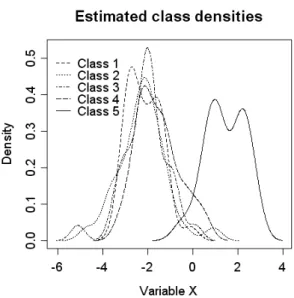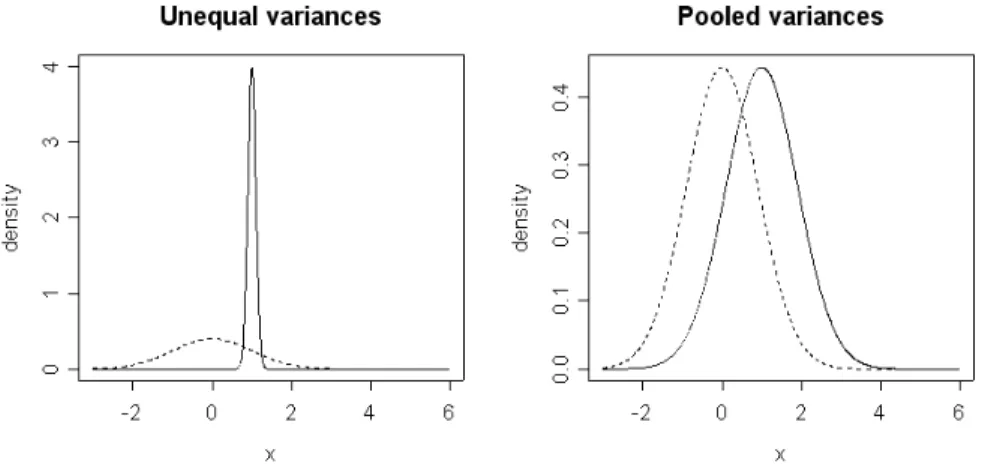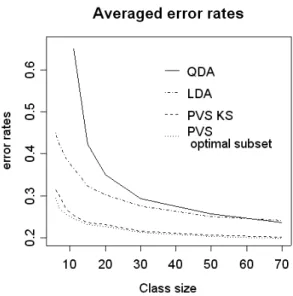Variable selection for discrimination of more than two classes where data are sparse
Gero Szepannek Claus Weihs
Lehrstuhl f¨ ur Computergest¨ utzte Statistik Fachbereich Statistik
Universit¨ at Dortmund
Abstract In classification, with an increasing number of variables, the required number of observations grows drastically. In this paper we present an approach to put into effect the maximal possible variable selection, by splitting a K class classification problem into pairwise problems. The principle makes use of the possibility that a variable that discriminates two classes will not necessarily do so for all such class pairs.
We further present the construction of a classification rule based on the pairwise solutions by the Pairwise Coupling algorithm according to Hastie and Tibshirani (1998). The suggested proceedure can be applied to any classification method.
Finally, situations with lack of data in multidimensional spaces are investigated on different simulated data sets to illustrate the problem and the possible gain.
The principle is compared to the classical approach of linear and quadratic discriminant analysis.
1 Motivation and idea
In most classification procedures, the number of unknown parameters grows more than linearly with dimension of the data. It may be desirable to apply a method of variable selection for a meaningful reduction of the set of used variables for the classification problem.
In this paper an idea is presented as to how to maximally reduce the number of used variables in the classification rule in a manner of partial variable selection.
To motivate this, consider the example of 5 classes distributed in a variable as
it is shown in figure 1. It will be hardly possible to discriminate e.g. whether
an observation is of class 1 or 2. An object of class 5 instead will probably be
well recognized. The following matrix (rows and coloumns denoting the classes)
Figure 1: Example of 5 classes.
shows which pairs of classes can be discriminated in this variable:
C2 C3 C4 C5
C1 − − − +
C2 − − +
C3 − +
C4 +
(1)
We conclude that, since variables may serve for discrimination of some class pairs while at the same time not doing so for others, a class pair specific variable selection may be meaningful. Therefore we propose the following procedure:
1. Perform ”maximal” variable subset selection for all K(K −1)/2 class pairs.
2. Build K(K − 1)/2 class pairwise classification rules on possibly differing variable subspaces.
3. To classify a new object, perform K(K −1)/2 pairwise decisions, returning the same number of pairwise posterior probabilities.
The remaining question consists in building a classification rule out
of these K(K − 1)/2 pairwise classifiers.
2 Pairwise Coupling
2.1 Definitions
We now tackle the problem of finding posterior probabilities of a K-class clas- sification problem given the posterior probabilities for all K(K − 1)/2 pairwise comparisons. Let us start with some definitions.
Let p(x) = p = (p
1, . . . , p
K) be the vector of (unknown) posterior probabilities.
p depends on the specific realization x. For simplicity in notation we will omit x.
Assume the ”true” conditional probabilities of a pairwise classification problem to be given by
ρ
ij= P r(i|i ∪ j) = p
ip
i+ p
j(2) Let r
ijdenote the estimated posterior probabilities of the two-class problems.
The aim is now to find the vector of probabilities p
ifor a given set of values r
ij.
2.1.1 Example 1:
Given p = (0.7, 0.2, 0.1). The ρ
ijcan be calculated according to equation 2 and can be presented in a matrix:
{ρ
ij} =
. 7/9 7/8
2/9 . 2/3
1/8 1/3 .
(3)
The inverse problem does not necessarily have a proper solution, since there are only K − 1 free parameters but K(K − 1)/2 constraints.
2.1.2 Example 2:
Consider
{r
ij} =
. 0.9 0.4 0.1 . 0.7 0.6 0.3 .
(4)
From Machine Learning, majority voting (”Which class wins most comparisons
?”) is a well known approach to solve such problems. But here, it will not lead to a result since any class wins exactly one comparison. Intuitively, class 1 may be preferable since it dominates the comparisons the most clearly.
2.2 Algorithm
In this section we present the Pairwise Coupling algorithm of Hastie and Tib-
shirani (1998) to find p for a given set of r
ij. They transform the problem into
an iterative optimization problem by introducing a criterion to measure the fit
between the observed r
ijand the ˆ ρ
ij, calculated from a possible solution ˆ p. To measure the fit they define the weighted Kullback-Leibler distance:
l(ˆ p) = X
i<j
n
ijr
ij∗ log r
ijˆ ρ
ij+ (1 − r
ij) ∗ log
1 − r
ij1 − ρ ˆ
ij(5)
n
ijis the number of objects that fall into one of the classes i or j.
The best solution ˆ p of posterior probabilities is found as in Iterative Proportional Scaling (IPS) (for details on the IPS-method see e.g. Bishop, Fienberg and Holland, 1975). The algorithm consists of the following three steps:
1. Start with any ˆ p and calculate all ˆ µ
ij.
2. Repeat until convergence i = (1, 2, . . . , K, 1, . . .):
ˆ p
i← p ˆ
i∗
P
j6=i
n
ijr
ijP
j6=i
n
ijρ ˆ
ij(6) renormalize ˆ p and calculate the new ˆ µ
ij3. Finally scale the solution to ˆ p ←
Ppˆipˆi
2.2.1 Motivation of the algorithm:
Hastie and Tibshirani (1998), show that l(p) increases at each step. For this reason, since it is bounded above by 0, the algorithm converges. The limit satis- fies P
i6=j
n
ijρ
ij= P
i6=j
n
ijr
ijfor every class i = 1, . . . , K if a solution p exists.
ˆ
p and ˆ ρ
ijare consistent.
Even if the choice of l(p) as optimization criterion is rather heuristic, it can be motivated in the following way: consider a random variable n
ijr
ij, being the rate of class i among the n
ijobservations of class i and j. This random variable can be considered to be binomially distributed n
ijr
ij∼ B (n
ij, ρ
ij) with ”true”
(unknown) parameter ρ
ij. Since the same (training) data is used for all pairwise estimates r
ij, the r
ijare not independent, but if they were, l(p) of equation 5 would be equivalent to the log-likelihood of this model (see Bradley and Terry, 1952). Then, maximizing l(p) would correspond to maximum-likelihood estima- tion for ρ
ij.
Going back to example 2, we obtain ˆ p = (0.47, 0.25, 0.28), a result being consis- tent with the intuition that class 1 may be slightly preferable.
3 Validation of the principle
In this section, the suggested procedure of a pairwise variable selection combined with Pairwise Coupling [PVS] is compared to usual classification using linear and quadratic discriminant analysis [LDA, QDA].
Variable selection:
The method of variable selection in our implementation is a quite simple one.
We used class pair - wise Kolmogorov-Smirnov tests (see Hajek, 1969, pp.62–69) to check whether the distributions of two classes differ in a variable or not. For every class pair and every variable, the statistic
D = max
x


